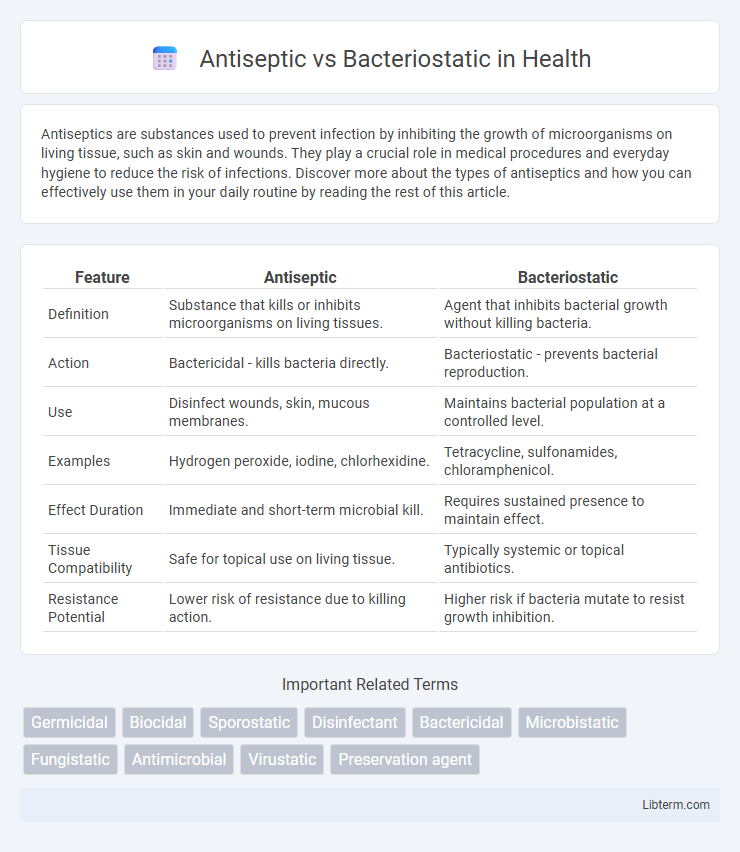Antiseptics are substances used to prevent infection by inhibiting the growth of microorganisms on living tissue, such as skin and wounds. They play a crucial role in medical procedures and everyday hygiene to reduce the risk of infections. Discover more about the types of antiseptics and how you can effectively use them in your daily routine by reading the rest of this article.
Table of Comparison
| Feature | Antiseptic | Bacteriostatic |
|---|---|---|
| Definition | Substance that kills or inhibits microorganisms on living tissues. | Agent that inhibits bacterial growth without killing bacteria. |
| Action | Bactericidal - kills bacteria directly. | Bacteriostatic - prevents bacterial reproduction. |
| Use | Disinfect wounds, skin, mucous membranes. | Maintains bacterial population at a controlled level. |
| Examples | Hydrogen peroxide, iodine, chlorhexidine. | Tetracycline, sulfonamides, chloramphenicol. |
| Effect Duration | Immediate and short-term microbial kill. | Requires sustained presence to maintain effect. |
| Tissue Compatibility | Safe for topical use on living tissue. | Typically systemic or topical antibiotics. |
| Resistance Potential | Lower risk of resistance due to killing action. | Higher risk if bacteria mutate to resist growth inhibition. |
Introduction to Antiseptics and Bacteriostatics
Antiseptics are chemical agents applied to living tissues to reduce or eliminate pathogenic microorganisms, preventing infection by killing or inhibiting their growth. Bacteriostatics specifically inhibit bacterial reproduction without necessarily killing the microbes, allowing the immune system to eliminate the pathogens. These distinctions influence their clinical applications, with antiseptics primarily used for wound care and skin disinfection, while bacteriostatics are often employed in controlling bacterial populations in various medical and laboratory settings.
Defining Antiseptics: Purpose and Mechanism
Antiseptics are substances applied to living tissues to reduce the risk of infection by killing or inhibiting the growth of microorganisms. Their primary purpose is to prevent infection by destroying bacteria, viruses, fungi, and other pathogens at wound sites or surgical areas. The mechanism of antiseptics involves disrupting microbial cell membranes, denaturing proteins, or interfering with essential enzyme systems, effectively neutralizing harmful microbes without causing significant damage to human tissues.
What Are Bacteriostatic Agents?
Bacteriostatic agents inhibit the growth and reproduction of bacteria without directly killing them, allowing the immune system to eliminate the pathogens. Common bacteriostatic substances include tetracyclines, sulfonamides, and chloramphenicol, which interfere with bacterial protein synthesis and metabolic functions. These agents are crucial in controlling infections by preventing bacterial proliferation while minimizing damage to host tissues.
Key Differences Between Antiseptics and Bacteriostatics
Antiseptics are chemical agents applied to living tissues to kill or inhibit the growth of microorganisms, providing immediate microbial reduction. Bacteriostatics inhibit bacterial growth and reproduction without necessarily killing the bacteria, allowing the immune system to eliminate the pathogens. The key difference lies in their action mechanism: antiseptics exhibit bactericidal activity with direct microbial destruction, while bacteriostatics exert bacteriostatic effects by halting bacterial proliferation.
Applications of Antiseptic Solutions
Antiseptic solutions are primarily used in medical settings to prevent infections by killing or inhibiting the growth of microorganisms on living tissues, such as skin and mucous membranes. Common applications include preoperative skin preparation, wound cleaning, and hand hygiene in healthcare environments. Unlike bacteriostatic agents, which only inhibit bacterial growth, antiseptics actively destroy a broad spectrum of pathogens to reduce microbial contamination.
Uses and Benefits of Bacteriostatic Agents
Bacteriostatic agents inhibit bacterial growth and reproduction without killing the bacteria outright, making them ideal for applications where controlled bacterial presence is crucial, such as in wound care and infection prevention. These agents are commonly used in medical settings for prolonged treatments because they reduce bacterial populations while allowing the immune system to effectively combat pathogens. Benefits of bacteriostatic agents include minimizing bacterial resistance development and preserving beneficial microflora, which supports faster healing and reduces the risk of secondary infections.
Safety Considerations and Side Effects
Antiseptics are designed to kill or inhibit a broad spectrum of microorganisms on living tissues and often contain chemicals like chlorhexidine or iodine, which may cause skin irritation or allergic reactions in sensitive individuals. Bacteriostatic agents inhibit bacterial growth without killing bacteria outright, typically resulting in fewer side effects but requiring intact immune function to eliminate the infection. Choosing between antiseptic and bacteriostatic treatments involves evaluating patient-specific factors such as skin sensitivity, risk of allergic response, and the severity of infection to minimize adverse effects while ensuring effective microbial control.
Choosing the Right Agent: Factors to Consider
Choosing the right agent between antiseptics and bacteriostatic compounds depends on the application site, desired microbial control, and safety profile. Antiseptics such as chlorhexidine or iodine provide rapid broad-spectrum microbial killing suitable for wound cleaning, while bacteriostatic agents like tetracycline inhibit bacterial growth, ideal for prolonged use in infections without promoting resistance. Consider factors like tissue toxicity, microbial spectrum, and intended duration of action to optimize infection control and patient outcomes effectively.
Common Misconceptions About Antiseptics and Bacteriostatics
Many people mistakenly believe antiseptics and bacteriostatics serve the same purpose, but antiseptics actively kill or inhibit a broad range of microorganisms on living tissues, whereas bacteriostatics specifically halt bacterial growth without necessarily destroying the bacteria. Another common misconception is that bacteriostatic agents can be used interchangeably with antibiotics, though their function is limited to preventing bacterial proliferation rather than eliminating infection. Understanding these distinctions is crucial for effective infection control and appropriate clinical application.
Summary: Antiseptic vs Bacteriostatic Effectiveness
Antiseptics effectively kill or inhibit a broad spectrum of microorganisms on living tissues, providing rapid disinfection by destroying bacteria, viruses, and fungi. Bacteriostatic agents specifically inhibit bacterial growth and reproduction without necessarily killing the bacteria, allowing the immune system to eliminate the pathogens. The effectiveness of antiseptics is immediate and broad, while bacteriostatic substances rely on halting bacterial proliferation to control infection over time.
Antiseptic Infographic

 libterm.com
libterm.com